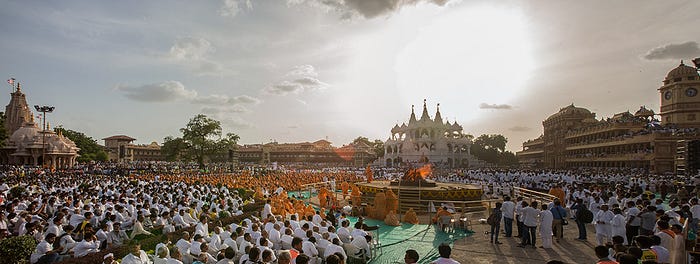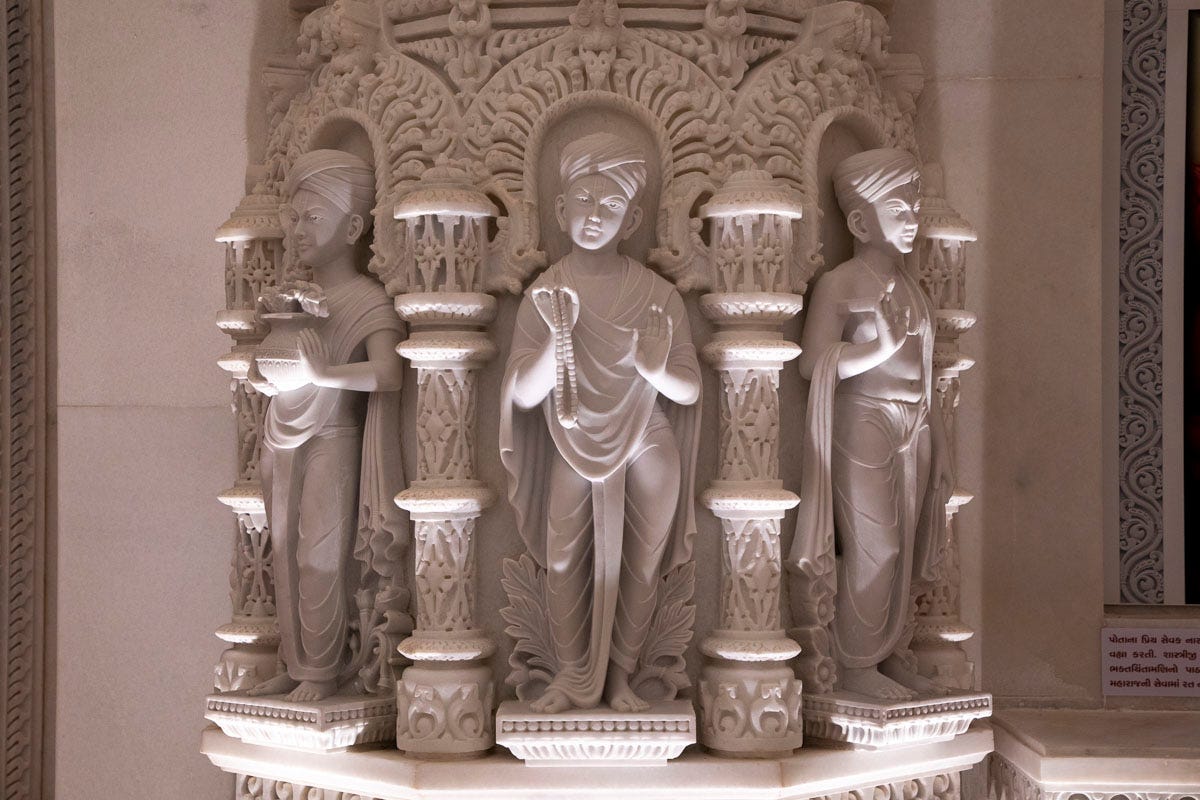The Ultimate Tribute to the Ultimate Guru
The story behind Pramukh Swami Maharaj’s Smruti Mandir


His Holiness Pramukh Swami Maharaj (1921–2016) has impacted the lives of millions around the world by inspiring better living through his love, harmony and faith. He never saw himself as a spiritual leader of a worldwide organization, BAPS Swaminarayan Sanstha. He always saw himself as a humble servant of others. It is unfathomable how such a person has walked in flesh and blood as his service to humanity is not humanly possible.
And on August 13, 2016, his physical departure from this Earth was a loss felt greater than the loss of a spiritual leader, but the feeling of loss of a mentor, friend and a parent.
How can one offer the ultimate tribute to the ultimate guru?
My Final Spot
The cremation site was chosen by Pramukh Swami Maharaj himself. However, the location that was selected was not ordinary.
Pramukh Swami Maharaj choose his final resting spot. He wished, “May my guru Shastriji Maharaj’s drashti (divine grace) forever shower upon me and may I forever have the darshan of Bhagwan Swaminarayan.”

Such a spot could only be in Sarangpur, Gujarat. On the left side of Pramukh Swami Maharaj’s final resting location lies Shastriji Maharaj’s Smruti Mandir and in front lies the main mandir, which houses the murtis of Shri Akshar-Purushottam Maharaj. Pramukh Swami Maharaj’s hand chosen location is the pinnacle of his life’s mission— eternal devotion to God and guru.
Pramukh Swami Maharaj’s favorite mandir was Sarangpur mandir. He was the kothari (head) of Sarangpur mandir from 1946 until 1950. However, the real reason why this was his favorite mandir was because it was his guru, Shastriji Maharaj’s favorite location and final resting location. There are countless memories of young Sadhu Narayanswarupdas (Pramukh Swami Maharaj) with Shastriji Maharaj in Sarangpur. For him, it was God’s divine abode on Earth.
History of the Smruti Mandir
Prior to Pramukh Swami Maharaj departing this Earth, very few knew about his inner wish.
Originally, it was planned that a bronze murti of Bhagwan Swaminarayan riding his horse, Rojho Ghodo, would be placed there. The murti inspired by Pramukh Swami Maharaj for the anniversary of Sarangpur Mandir’s centennial celebration. The murti enwas to remember Bhagwan Swaminarayan’s visit to the small village and outlining the future mandir in Sarangpur while riding Rojho Ghodo. However, upon understanding Pramukh Swami Maharaj’s wish, this was moved close to the main mandir.

It was only when Pramukh Swami Maharaj reverted back to Akshardham that all realized his final wish. The crematory platform was 32 feet in diameter and octagonally shaped. At its center was located the 10 ft by 10 ft main crematory area.
Following Pramukh Swami Maharaj’s final rites, a small deri was created in order to allow for devotees and well-wishers to remember Pramukh Swami Maharaj and offer their prayers. Devotees would offer prakashina, dandavat, mala and various other forms of devotion.

At first glance, the location is such that there is not much space to construct a large mandir in his memory in the future. This is a shining example of Pramukh Swami Maharaj’s innate humility. His ensured that such a spot should be chosen that my devotees would not be able to construct a mandir larger than Bhagwan or my guru.
Over time, His Holiness Mahant Swami Maharaj, Pramukh Swami Maharaj’s spiritual successor, inspired to create a permanent mandir on top of Pramukh Swami Maharaj’s samadhi location.
He inspired and wished for the Smruti Mandir to be completed in time for Pramukh Swami Maharaj’s Shatabdi Mahotsav (Birth Centennial Celebrations)!
6–7 designs were created and shown to His Holiness Mahant Swami Maharaj and senior swamis and the current design was chosen.

Within 2 years, the Smruti Mandir was built and on January 26, 2023 — the auspicious Hindu festival of Vasant Panchmi and the birth anniversary of Shastriji Maharaj — the Smruti Mandir was inaugurated with joy and grandeur.
The Smruti Mandir: A Reflection of Swamishri
A Smruti Mandir is built in remembrance of one’s guru upon their final resting location. In ancient India, kings would often build palaces and forts that would be a reflection of their values and legacy. Similarly, it only makes sense to build a Smruti Mandir that reflect the legacy of Pramukh Swami Maharaj.
The Smruti Mandir is made with Pramukh Swami Maharaj’s favorite stone — Makrana marble. Pramukh Swami Maharaj visited Makarana, Rajasthan many times upon the wish of his gurus. Makarana marble is quote difficult to find, especially stones which are spotless. However, marble was able to be found for this unique mandir.

The ghummat (dome) and four samaran (cone-shaped dome) is in the style of Swaminarayan Akshardham in New Delhi. One of the most prominent mandirs built by Pramukh Swami Maharaj is Swaminarayan Akshardham as a testament of his devotion to God and his gurus, his commitment towards spreading universal values and his wish to inspire better living. This iconic style
The jagti (base of the Smruti Mandir) contains the support of Pramukh Swami Maharaj’s life — his swamis and devotees.
Pramukh Swami Maharaj inspired over 1,000 educated youths to join the Hindu monastic order to whole-heartedly serve God, guru and society. He also established a formal monastic training center in Sarangpur to allow youths to aid in their spiritual journey. Hence, the jagti showcases Pujya Swamis performing various seva (selfless services) — from cooking to delivering discourses to meditation and everything in between. Pujya Santo performing various Sevas.
In between the Pujya Swamis are shikhars (pinnacles) to showcase the over 1,200 mandirs built by Pramukh Swami Maharaj worldwide.
Each corner of the jagti showcases senior Swamis who have lived closely with Pramukh Swami Maharaj, from Shastriji Maharaj’s time to Pujya Sant Swami. The jagti also showcases foremost devotees who were integral in furthering the Akshar-Purushottam Darshan (the philosophical tradition of BAPS) from Shastriji Maharaj until Pramukh Swami Maharaj’s final days.

Across the top of the jagti, small lotus flowers are carved with various devotees within the flowers. These flowers showcase the diversity of devotees and well-wishers who came to Pramukh Swami Maharaj to seek his blessings. The variety of the demographic is astonishing — young and old, men and women, Indian and American and more.
The mandovar (exterior wall of the Mandir) showcases the paramhansas and devotees of Bhagwan Swaminarayan. Pramukh Swami Maharaj would often praise the paramhansas and the devotees of Bhagwan Swaminarayan during his discourses to provide inspiration in one’s spiritual journey.

Some of Pramukh Swami Maharaj‘s favorite designs that are carved into traditional shikkharbaddh mandirs have also been embedded throughout the Mandir, such as a shankh (counch shell), ghant (bell), Akshar Deri, peacocks and elephants.
Typically, mandirs would have wooden doors. In order to fulfill Pramukh Swami Maharaj’s wish of having his guru’s grace forever upon him and having the darshan of Bhagwan Swaminarayan, all sides of the Smruti Mandir have glass doors.


There are eight half-pillard within inside the Smruti Mandir. Traditionally, Hindu devtas, devis and rishis are carved into pillars as they are the upholders of Sanatana Dharma. The question is then posed, who can uphold Pramukh Swami Maharaj’s work and continue his legacy? The answer are his devotees. Hence the pillars showcase:
- Divine balaks-balikas (children)
- Divine yuvak-yuvatis (youths)
- Divine vadils-mahilas (adults)
- Divine swamis (Hindu monks)
The center of the Smruti Mandir is the main 10 ft by 10 ft where Pramukh Swami Maharaj’s final rites occurred. The final resting spot has been preserved with a casing since August 17, 2016. This spot now has a special casing on top to preserve the originality and sanctity of the location.
Bhagwan Swaminarayan’s charanavind (holy footprints) have been placed on top of the casing and in front of the casing to allow devotees and well-wishers to offer their prayers. This unique style allows for devotees to perform darshan and offer pradakshinas and other forms of devotion.
Behind the casing are the murtis of Shri Akshar-Purushottam Maharaj and Pramukh Swami Maharaj.
The murtis of Shri Akshar-Purushottam — Parabrahman Bhagwan Shri Swaminarayan and Aksharbrahman Gunatitanand Swami — are consecrated as this was the heart of Pramukh swami Maharaj. He propagated Bhagawan Swaminarayan’s philosophy, known as Akshar-Purushottam Darshan, worldwide through consecrating mandirs and inspiring the writing of scriptures.
Pramukh Swami Maharaj’s murti is a unique murti, known as a lakshni murti (a murti that depicts characteristics). A traditional murti in sukhasana has been consecrated behind Shastriji Maharaj’s Smruti Mandir. The murti consecrated in the Smruti Mandir is in the style of Pramukh Swami Maharaj performing katha-varta (discourses) in his innocent, yet divine nature. His right hand is holding a mala while resting on a pillow, while his left hand resting on his heart.


The uniqueness of the Smruti Mandir is a reflection of Pramukh Swami Maharaj’s everlasting legacy. His Smruti Mandir is a remembrance of his wholehearted devotion to God and gurus, his innate humility and his everlasting legacy through mandirs, swamis and his devotees.
Truly, as long as the sun’s light remains on this earth,
As long as the stars and moon remain lit,
‘O Pramukh Swami, your story and glory will ever remain!
This article is based on this first-hand account of Pujya Shrijiswarup Swami, one of the swamis involved in building Pramukh Swami Maharaj’s Smruti Mandir.

